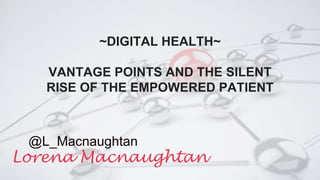Digital Health: Vantage Points and the Silent Rise of the Empowered Patient
- 1. ~DIGITAL HEALTH~ VANTAGE POINTS AND THE SILENT RISE OF THE EMPOWERED PATIENT Lorena Macnaughtan @L_Macnaughtan
- 4. State Market Citizen Medical Professio n Science Regulators Payers Digital Health companies IT&C companies Pharma Genomics Biotech Consultancies Patients Carers ¡ people Physicians Non-physician personnel Researchers Academics Health of population Market opportunity Wellbeing Autonomy Illness Knowledge
- 5. First published by Lorena Macnaughtan in The Curious Case of Digital Health, May 2015, on nuviun,com. graphic design by nuviun,com.
- 6. First published by Lorena Macnaughtan in Alll Eyes on Digital Health, May 2015, on nuviun,com. graphic design by nuviun,com.
- 14. State Market Citizen Medical Prof. Science Treatment Doctor - > Patient Education Medical sources - > Peers & other sources Health data ownership Doctor/Grey area - > Patient
Editor's Notes
- #2: In Digital Health, the patient is not what it used to be¡
- #3: A new field emerges when others fail to adapt¡, to respond to existing needs, innovation or uncertainty. With the arrival of smartphones and sensing devices, we see Digital Health develop as an interstice between several fields: healthcare related and digital technologies. On one side, we have thickness of ties, skepticism, paternalism, on the other, we have ingenuity, autonomy, speed.
- #4: Various players enter this world. They have their own vantage points, or institutional logics - meaning their own values, perspectives, or¡ biases.
- #5: There are 5 such logics DH. In the middle row, I¡¯ve listed some of their representatives, with the caveat that in reality, they care these logics in less pure forms. For State, we have regulators and payers, for market all colours digital health companies, insurers, pharma etc. For Citizen - patients, carers, people¡ We have doctors, nurses for medical profession and researchers and academics for the science logic. Just based on their focus, the last row, it¡¯s not difficult to flash out tensions.
- #6: This mobilisation of players brought to light various issues. And so, we understand why often DH solutions attempt to solve a problem, but create or reveal tensions elsewhere.
- #7: Fields, at first, evolve around issues, as an effort to redefine a greater good. At the core of Digital Health, we have witnessed the silent rise of the new, empowered patient - as a paradigm shift for a better, more convenient, more comprehensive healthcare.
- #8: Having the many DH players in mind, let¡¯s take a test drive. You will see a few images. For each, let¡¯s think who could consider the patient from this angle.
- #9: patients, insurers, doctors..
- #10: what about this?
- #11: or this¡? pharma, patients for home-testing
- #13: patients for autonomy, convenience, advocacy researchers for clinical trials, big data states even?
- #14: Most images invoke several stakeholders, because the empowered patient is not the result of patient emancipation alone.
- #15: There are multiple negotiation points - here, only a few. I used traffic lights colours to indicate support (green), challenge (red) and ambivalence (yellow). Grey signifies that a logic is less invested in the matter. Better, let¡¯s take an example: Wearable producers - however unintentionally Challenge the medical profession logic, by unleashing this stream of self-generated data. They challenge reimbursement (state logic)¡ for patient management, diagnostics¡ - And finally, they indirectly support patient ownership over their health data - the citizen logic.
- #16: Having a deep understanding of the DH canvas allows you to build in contingencies. Each strategic decision, each choice for product or service design is a bet against several potential futures. It not only assumes roles and practices, but also a certain evolution of technology, science, economy, society and even morality.
- #17: The empowered patient is still in the making and it does not evolve in isolation. Therefore, I am asking you: Does patient empowerment call for doctors (re-)empowerment or are they mutually exclusive? Will it empower or disempower other stakeholders?
- #18: In Digital Health, the patient is not what it used to be¡ but neither is the doctor, the insurer, pharma or other stakeholders¡ Digital Health¡¯s capacity to transform healthcare, relies not only on technology and Big Data, but primarily on the ability of its players to negotiate over these emerging roles.

















